Transcription of Material Safety Data Sheet A-1480 Part B
1 MSDS A-1480 Part B1 Material Safety data SheetA-1480 Part BCHEMTREC: 800-424-9300 PREPARATION DATE: 01/05 IDENTIFICATIONPRODUCT NAME:Clear Top Coat Sealer 60% Solids PolyurethanePRODUCT NUMBER:A -1480 Part BCHEMICAL FAMILY:POLYESTER POLYOL IN ORGANIC INGREDIENTSI ngredient NameCAS NumberConcentration(%) propylene glycol monomethyl Ether Acetate108-65-620-45%Benzene, 1-Cloro-4(trifluoromethyl)-98-56-610-25% Proprietary Ingredients10-25%EMERGENCY OVERVIEWWARNING:Color: CloudyForm: LiquidOdor: SolventFlammable. May cause eye, skin, and respiratory tract irritation. Also harmful byinhalation and if swallowed. Vapors may travel to areas away from worksite beforeigniting/flashing back to vapor source. Vapors or mist may be a fire and explosionhazard when exposed to high temperature or ignition. Closed container mayforcibly rupture under extreme heat. Toxic fumes are produced during a firesituationwhen product is combined with phosphorus-containing Material .
2 Reportshave associated repeated and prolonged occupational overexposure to solvents withpermanent brain and nervous system damage. Intentional misuse by deliberatelyconcentrating and inhaling solvents may be harmful or fatal. May affect Health EffectsPrimary Route of Entry:Skin Contact, Eye Contact, Ingestion, InhalationMedical Conditions AggravatedBy Exposure:Skin disorders, Respiratory disorders, Eye disordersNFPA 704M RatingHealth2 Flammability3 Reactivity0 Other0= Minimal 1=Slight 2=Moderate 3=Serious 4=SevereAmericrete, Reagan WayMurrieta, Ca 92562 Toll Free(800) 775-8880 Technical Help (800) 775-8880 MSDS A-1480 PartB2*= Chronic Health HazardHMIS RatingHealth2*Flammability3 Physical Hazard00= Minimal 1=Slight 2=Moderate 3=Serious 4=Severe* = Chronic Health PROPERTIESP hysical Form:LiquidColor:CloudyOdor:SolventBoili ng Point:Begins at C (180 F) Estimated based on componentsMelting/Freezing Point:Not EstablishedSolubility in Water:InsolubleSpecific @ 77 F (25 C)Bulk lbs/gal% Volatile By Volume.
3 Approximately 29%Vapor mmHg (PMA) @ 20 C (68 F) AND EXPLOSION DATAF lash F ( C) Setaflash (ASTMD-3243,D-3278, D-3828)Flammable Limits:Upper Explosive Limit (UEL) (%) @ 283 F PMAL ower Explosive Limit (LEL) (%) @ 173 F PMAE xtinguishing Media:All extinguishing media are Fire Fighting Procedures:Firefighters should be equipped with self-contained breathing apparatus to protect againstpotentially toxic and irritating fumes. Use cold water to cool fire-exposed containers to minimize riskof Fire/Explosion Hazards:Flammable may spread long distances and ignite. Vapors or mist may be a fire andexplosion hazard when exposed to high temperature or ignition. Toxic and irritating gases/fumesmay be given off during burning or thermal decomposition. If this polyol is combined withphosphorus compounds, trimethylolpropanesphosphate (TMPP), a known neurotoxin, can be givenoff in the event of a fire.
4 Therefore, we do not recommend mixing this polyol with HEALTH DATAR oute(s) of Entry:Inhalation, Skin Contact, EyeHuman Effects and Symptoms of Overexposure:Acute Inhalation: Solvent vapors are irritating to the eyes, nose, throat and respiratory tractresulting in red, itchy eyes, dryness of the throat and tightness in the chest. Other possible symptomsof overexposure include headache, nausea, narcosis, fatigue and loss of A-1480 PartB3 Chronic Inhalation: Chronic exposure to organic solvents has been associated with variousneurotoxic effects including permanent brain and nervous system damage. Symptoms include loss ofmemory, loss of intellectual ability, and loss of Skin Contact: Repeated or prolonged skin contact with the solvent can result in dry, defattedand cracked skin causing increased susceptibility to infection. In addition, dermatitis and skin rashand redness may occur from skin contact.
5 Solvents may penetrate the skin causing effects similar tothose identified under acute inhalation Skin Contact: Chronic skin exposure to the solvent may cause effects similar to thoseidentified under chronic inhalation Eye Contact: Liquid, aerosols or vapors are severely irritating and can cause pain, tearing,reddening and swelling. If left untreated, corneal damage can occur and injury is slow to , damage is usually Eye Contact: Prolonged vapor contact may cause Ingestion: Can result in irritation in the digestive tract. Symptoms can include sore throat,abdominal pain, nausea, vomiting and diarrhea. Vomiting may cause aspiration of solvent resultingin chemical Ingestion: Chronic exposure to organic solvents has been associated with various neurotoxiceffects including permanent brain and nervous : This product is not listed by NTP, IARC or regulated as a carcinogen by AND FIRST AID PROCEDURESF irst Aid for Eyes: Flush with clean, lukewarm water (low pressure) for at least 15 minutes whileoccasionally lifting eyelids.
6 Obtain medical attention if irritation Aid for Skin: Remove contaminated clothing and wash affected areas thoroughly with soapand water. Wash contaminated clothing before Aid for Inhalation: Move to an areafree from risk of further exposure. Administer oxygen orartificial respiration as needed. Obtain medical Aid for Ingestion: DO NOT INDUCE VOMITING. DO NOT GIVE ANYTHING BY MOUTHTO AN UNCONSCIOUS PERSON. Consult RECOMMENDATIONSI ndustrial Hygiene/Ventilation Measures:General dilution and local exhaust as necessary to controlairborne vapors, mists, dusts and thermal decomposition products below appropriate airborneconcentration air may need to be cleaned by scrubbers or filters toreduce environmental contamination. Curing ovens must be ventilated to prevent the build up ofexplosive atmospheres and to prevent off gases from entering the Protection Requirements: Liquid chemical goggles in combination with a full-face lenses should not be Protection Requirements: Permeation resistant gloves (butyl rubber, nitrile rubber).
7 Cover asmuch of the exposed skin area as possible with appropriate clothing. If skin creams are used, keepthe area covered only by the cream to a Requirements: The use of a positive pressure supplied air respirator ismandatory when: airborne concentrations are not known; airborne solvent levels are 10 times theappropriate TLV; spraying is performed in a confined space or area with limited Protective Measures: Employees should wash their hands and face before eating,drinking, or using tobacco products. Educate and train employees in the safe use and handling ofthis product. Emergency showers and eyewash stations should be DATAS tability:This is a stable Polymerization:Will not :Heat, flames and A-1480 PartB4 Instability Conditions:None Products:By fire and thermal decomposition: CO, CO2, oxides of nitrogen(NOx), dense black smoke, other undetermined AND LEAK PROCEDURESS pill orLeak Procedures:Cleanup personnel must use appropriate personal protective all sources of ignition, including flames, heat and sparks.
8 Dike or dam spilled Material andcontrol further spillage, if possible. Do not allow spilled Material or wash water to enter sewers,surface waters, or groundwater systems. Cover spill with inert Material ( , dry sand or earth) andcollect for proper disposal. Wash spill are with soap and PRECAUTIONS & STORAGE DATAS torage Temperature (Min/Max):32 F (0 C)/122 F (50 C)Shelf Life:12 months at 77 F (25 C) in closed original Precautions:Keep away from heat, sparks and open flames. Ground and bondcontainers and equipment before transferring to avoid static sparks. Do not breathe vapors or spraymist. Avoid contact with eyes. Avoid contact with skin or clothing. Use only with adequateventilation/personal protection. Wash thoroughly after handling. Keep container closed when not Disposal MethodWaste disposal should be in accordance with existing federal, state and local environmental Container Precautions:Do not heat or cut container with electric or gas torch.
9 Recondition or dispose of empty container inaccordance with governmental regulations. Do not reuse empty container without proper precautions also apply to this container when INFORMATIONLAND TRANSPORT (DOT)Proper Shipping Name:Resin solution (contains propylene glycol MonomethylEther Acetate)Hazard Class or Division:3UN/NA Number:UN1866 Packaging Group:PG IIIH azard Label(s):Flammable LiquidHazard Placard(s):Flammable LiquidSEA TRANSPORT (IMO/ IMDG CODE) (OCEAN)Proper Shipping name:Resin solution (contains propylene glycol MonomethylEther Acetate)Hazard Class Division Number:3UN Number:UN1866 Packaging Group:IIIH azard Label(s):Flammable LiquidHazard Placard(s):Flammable LiquidAIR (ICAO/ IATA)MSDS A-1480 PartB5 Proper ShippingName:Resin solution (contains propylene glycol MonomethylEther Acetate)Hazard Class Division Number:3UN Number:UN1866 Packing Group:IIIH azard Label(s):Flammable DATAE cological data for propylene glycol MonomethylEther AcetateBiodegradationAcrobic, 100 %, Exposure time: 8 daysAcute and Prolonged Toxicity to FishLC50: 11 mg/l (Fathead minnow (Pimephales promelas), 96 hrs.)
10 Acute Toxicity to Aquatic InvertebratesEC50: 408 mg/l (Water flea (Daphnia magna), 48hrs) REGULATORY INFORMATIONOSHA Status:This product is hazardous under the criteria of theFederal OSHA Hazard communication Standard 29 CFR Status:On TSCA InventoryCERCLA Reportable Quantity:None ReportedSARA TitleIII:Section 302US EPA Emergency Planning and Community Right-ToKnow Act (EPCRA)Extremely hazardous Substance (40 CFR 355, AppendixA) Components: NoneSection 311/312 Categories:Acute Health Hazard, Chronic Health Hazard, FireHazardSection 313 Toxic Categories:NoneRCRA Status:When discarded in its purchased form, this productmeets the criteria of ignitability, and should bemanaged as a hazardous waste (EPA Hazardous WasteNumber D001). (40 CFR ) REGULATORYINFORMATIONS tate Right-To-Know Information:The following chemicals are specifically listed by individualstates; other product specific health and Safety data in other sections of the MSDS may also beapplicable for state requirements.








